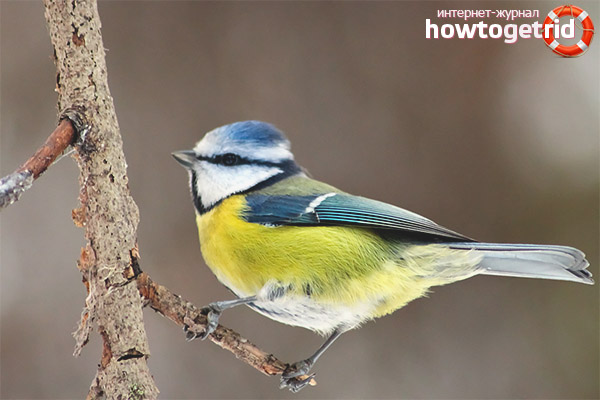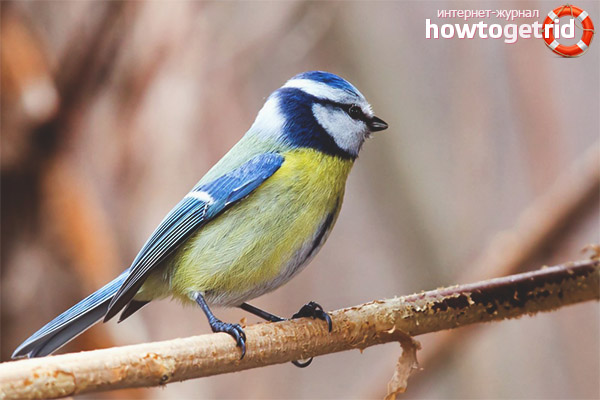The content of the article
Under the common blue tit is understood a tit, the plumage of which is pigmented with a yellow-blue tint. These individuals are especially common in African and Asian countries, and they also live in Europe. They choose exclusively deciduous or mixed forests for permanent residence, like birch trees and oaks.
Description
- These birds are not classified as shy, they often create various urban populations and enjoy living next to humans. They can let people near themselves at a fairly close distance and even eat with their hands.
- By a bird we mean a little titmouse with a short and strong beak. The tail is also shortened, as if cut off at the end. The blue tit in its overall characteristics is slightly inferior to the great tits, but it is considered slightly larger than the Muscovite. Along the length of the body, the individual grows to 12 cm, this is with a mass of 12-15 gr.
- The bird stands out for its color. She has stripes pigmented in blue. They are dark, extending from the beak to the eyes, after which they close on the occipital part. Also on the head there is a so-called cap of blue-and-blue tide.
- By external characteristics, these birds are quite beautiful. In their neck area there is another blue strip. In appearance, it may seem that a collar is being worn on a bird. The frontal part with whitish cheeks. Occipital region, wings, tail blue-blue.
- By color, birds can be different. The back is pigmented with a greenish color with an olive tint. But due to the habitat, the back can be dyed in different colors. In the lower part, the bird is yellow-green, with a dark stripe. Bill is black, legs are gray with gray.
Lifestyle
- These individuals are quite common. In the wild, they prefer to live in a mixed or deciduous forest. These birds also live in urban environments. They love to live in gardens, squares and various parks where people feed individuals. Birds adapt quickly enough, they can build homes for posterity even on a pole.
- As for habitats, individuals are found in the vastness of our country, in European countries (with the exception of Iceland), in Africa (its western part), as well as in Asian countries and the Canaries. Some experts classify these birds as a separate species, because they differ in behavior from their counterparts.
- Individuals of the family under discussion quickly adapt to changes in terms of climate. Birds feel great in subtropical regions, as well as in harsh environments. From habitats can choose birch forest belts, as well as a grove or oak forest. Some birds live nearby with conifers, but this is rather the exception.
- Blue tit is distinguished not only by behavior, but also by an extraordinary way of life. Some flocks of these birds successfully exist in Siberia with cedar trees, as well as in Africa in broad-leaved forest bands. They even like palm trees located along the road in the urban part.
- If the climatic conditions are hot enough and the air itself is arid, blue tit will always choose a zone with proximity to water sources as a permanent habitat. The bird settles near lakes, reeds, small rivers.
- The species under discussion is characterized by a sedentary lifestyle, but nomads are also found. Those individuals that live in cold regions move to warm places for the wintering period. If the birds live in warmth, they do not need to move south. Youngsters are inclined to flights, old people feel good in the former environment.
- If we consider the aspect leading to migration, it is impossible not to touch on the human factor. As always, people do tremendous damage to the animal world. The feathered tribe was no exception. Deforestation, pollution of nature, killing of birds and their massive catch - this and much more leads to migration and a reduction in numbers.
- The considered individuals, therefore, try to adhere to such habitats. It is in deciduous forests, where old trees are most present, that a huge number of all kinds of larvae and similar food almost always live.
- Blue tit prefer to eat aphids, flies, caterpillars, butterflies, mosquitoes and a little less often spiders. It is worth noting that the individuals in question are of great benefit to gardeners. Such birds destroy pests that cause enormous damage to summer residents.
- In the warm season, birds find food in large quantities without any labor. As for cold weather, in such a period it becomes difficult for individuals. Often, in the winter, birds feast on deciduous plants and coniferous seeds. Often birds fly vast distances in search of food.
Breeding
- Individuals reach puberty after 1 year of life. At this time, the breeding season begins in birds, pairs form. During mating games, the males begin to flood with beautiful and loud songs. They fluff up the tail and begin to dance in front of the female.
- If the female answers the song to the male, then the pair has already formed. After this, the males begin to jealously guard their home and the chosen one. Often you can see skirmishes. In this case, the male begins to drive out strangers.
- The construction of a new home is exclusively done by the female. Often individuals equip nests in tree hollows. In this case, the procedure occurs at a sufficient height from the ground. You can often see that the female is trying to expand the hollow. She plucks the bark with her beak.
- As soon as the hollow is the right size, the female begins to bring feathers, branches, grass and moss into it. Separately, it is worth noting that the nests of the individuals in question are quite problematic to find in the forest.
- As for the blue tit, another subspecies of birds, their homes are so well camouflaged that to see them is an unrealistic task. Often, nests are located in thickets of willow or reeds. Moreover, even experienced ornithologists rarely cope with the detection of such birds.
- After the considered individuals completely equip the nest, the female proceeds to the landing of the offspring. In this case, in the clutch there can be a maximum of 12 eggs. Young growth begins to hatch into the light after a fortnight. All this time, the male protects his family and brings food.
- At this time, the male is very interesting to watch. If he suspects danger, the male begins to imitate the hiss of a snake or the buzzing of bees. Thus, the feathered scare away predators from its territory. During the season the couple reproduces 2 offspring.
- At first, the male exclusively deals with feeding young animals. A week later, the female begins to connect to the procedure. Young growth grows up pretty quickly. After only 20-25 days, the chicks become winged and can independently get their own food. Adults remain faithful to each other throughout life.
Birds feel great in cultivated landscapes, live in squares and gardens. People build feeders for them, of which they are happy to feed.
Video: common blue tit (Cyanistes caeruleus)











Submit